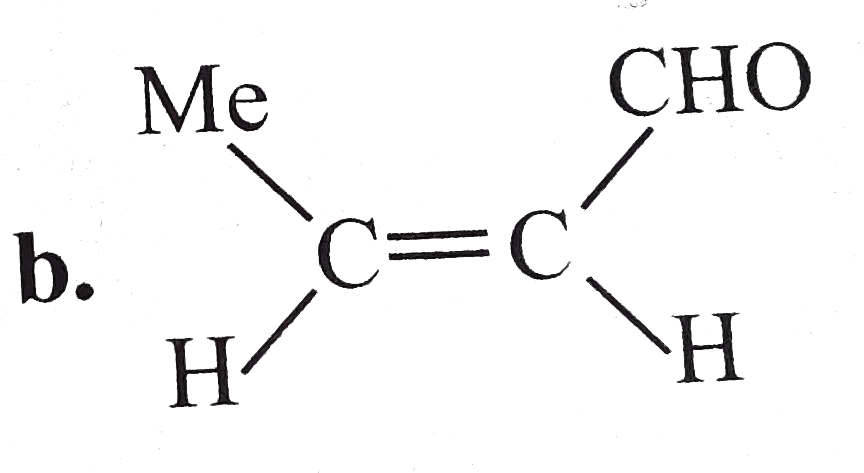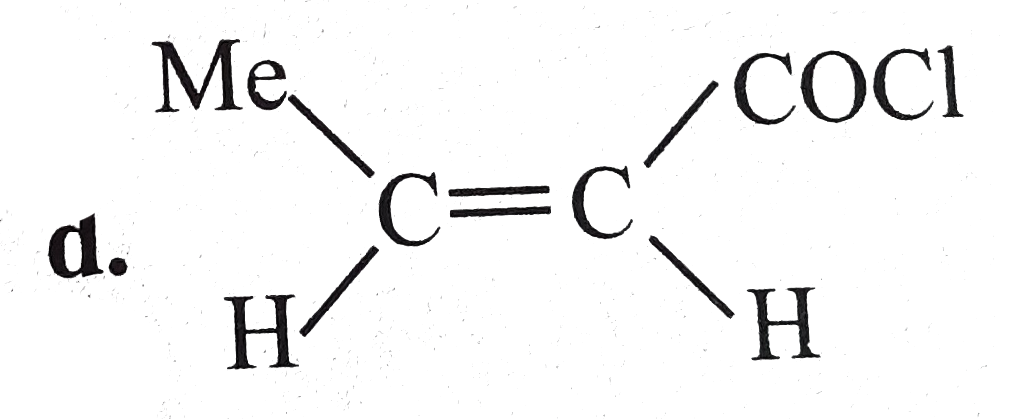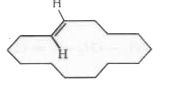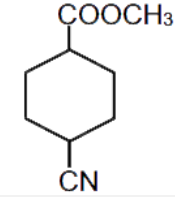MeC≡C−COClH2+Lindlar's Catalyst−−−−−−−−−−−−−→(A)
The Product (A) is:
a.Me−C≡C−CHO
b.
c.
d.
The correct Answer is:B
To solve the question, we need to analyze the reaction of the compound MeC≡C-COCl with hydrogen in the presence of Lindlar's catalyst. Let's break down the steps involved in this reduction reaction.
1. Identify the Reactant Structure:
The given compound is MeC≡C-COCl. This means we have:
- A methyl group (Me) attached to a carbon that is part of a triple bond (C≡C).
- The other end of the triple bond is connected to a carbon that has a carbonyl group (C=O) with a chlorine atom (Cl) attached, indicating it is an acid chloride.
2. Understanding Lindlar's Catalyst:
Lindlar's catalyst is a palladium-based catalyst that selectively reduces alkynes to cis-alkenes without further reducing them to alkanes. It can also reduce acid chlorides to aldehydes.
3. Reduction of the Triple Bond:
The triple bond (C≡C) in the compound will be reduced to a double bond (C=C) due to the presence of hydrogen (H2) and Lindlar's catalyst. This reduction occurs via cis addition, meaning that the hydrogen atoms will add to the same side of the double bond.
4. Reduction of the Acid Chloride:
The acid chloride (C=O with Cl) will be reduced to an aldehyde (C=O with H). The chlorine atom will be replaced by a hydrogen atom in this process.
5. Final Product Structure:
After applying the above reductions:
- The triple bond (C≡C) is converted to a cis double bond (C=C).
- The acid chloride (COCl) is converted to an aldehyde (CHO).
Therefore, the final product (A) will have the structure:
- MeC=C-CHO (where the double bond is between the first carbon and the second carbon, and the aldehyde group is at the end).
6. Conclusion:
The product (A) formed from the reaction of MeC≡C-COCl with H2 and Lindlar's catalyst is MeC=C-CHO.
Final Answer:
The product (A) is MeC=C-CHO.
The given compound is MeC≡C-COCl. This means we have:
- A methyl group (Me) attached to a carbon that is part of a triple bond (C≡C).
- The other end of the triple bond is connected to a carbon that has a carbonyl group (C=O) with a chlorine atom (Cl) attached, indicating it is an acid chloride.
Lindlar's catalyst is a palladium-based catalyst that selectively reduces alkynes to cis-alkenes without further reducing them to alkanes. It can also reduce acid chlorides to aldehydes.
The triple bond (C≡C) in the compound will be reduced to a double bond (C=C) due to the presence of hydrogen (H2) and Lindlar's catalyst. This reduction occurs via cis addition, meaning that the hydrogen atoms will add to the same side of the double bond.
The acid chloride (C=O with Cl) will be reduced to an aldehyde (C=O with H). The chlorine atom will be replaced by a hydrogen atom in this process.
After applying the above reductions:
- The triple bond (C≡C) is converted to a cis double bond (C=C).
- The acid chloride (COCl) is converted to an aldehyde (CHO).
Therefore, the final product (A) will have the structure:
- MeC=C-CHO (where the double bond is between the first carbon and the second carbon, and the aldehyde group is at the end).
The product (A) formed from the reaction of MeC≡C-COCl with H2 and Lindlar's catalyst is MeC=C-CHO.
The product (A) is MeC=C-CHO.
Topper's Solved these Questions
- REDUCTION AND OXIDATION REACTION OF ORGANIC COMPOUNDSBOOK - CENGAGE CHEMISTRY ENGLISHCHAPTER - REDUCTION AND OXIDATION REACTION OF ORGANIC COMPOUNDSEXERCISE - Exercise (Assertion And Reasoning)
10 Videos
- REDUCTION AND OXIDATION REACTION OF ORGANIC COMPOUNDSBOOK - CENGAGE CHEMISTRY ENGLISHCHAPTER - REDUCTION AND OXIDATION REACTION OF ORGANIC COMPOUNDSEXERCISE - Exercise Archives (Subjective)
26 Videos
- REDUCTION AND OXIDATION REACTION OF ORGANIC COMPOUNDSBOOK - CENGAGE CHEMISTRY ENGLISHCHAPTER - REDUCTION AND OXIDATION REACTION OF ORGANIC COMPOUNDSEXERCISE - Exercise (Multiple Correct)
35 Videos
- QUALITATIVE INORGANIC SALT ANALYSISBOOK - CENGAGE CHEMISTRY ENGLISHCHAPTER - QUALITATIVE INORGANIC SALT ANALYSISEXERCISE - Viva Voce Questions And Part-C (Analysis Of Cations)
42 Videos
- SOLID STATEBOOK - CENGAGE CHEMISTRY ENGLISHCHAPTER - SOLID STATEEXERCISE - Ex 1.2 (Objective)
9 Videos
Similar Questions
a) Draw the stereochemical structure of the product in the following reaction.
R−C≡C−RH2−−−−−−−−−→Lindlar's catalyst
b) Write down the structures of the stereoisomers formed when cis-2-butene is reacted with bromine.
View SolutionR−≡(A)−≡−RLindlar's catalyst+H2−−−−−−−−−−−−→(B)

Compounds (B) and (C) are:
View Solution
Knowledge Check
The reaction, RC≡CRH2−−−−−−−−−→Lindlar's catalystGives the main product as
Acis-alkeneBtrans-alkeneCalkaneDnone of thesePh−CH2−O∣∣C−OH(1)NaOH,CaO,Δ−−−−−−−−−−−−−−→(2)H⊕(A)
Product (A) is :APh−CO2HBPh−CH2−OHCPh−CH3D
Br−(CH2)12−C≡CHNaNH2−−−−→(A)Lindlar−−−−→Catalyst(B), Product (B) is
A B
B C
C DBr−(CH2)−CH=CH2
DBr−(CH2)−CH=CH2
H2+Ni←−−−−PhNO2LAH−−→(A).
The products (A) and (B) are:
View SolutionC2H5O−O∣∣C−OC2H52MeMgBr−−−−−→(A). The product (A) formed can:
View Solution_S01_501_Q01.png) H+−−→(A)
H+−−→(A)
The product (A) in the given reaction would be:
View SolutionMeCH(A)=O+H2NOH(B)HCOONa−−−−−→Δ(C)+H2O Product (C ) is:
View Solution DIBAL-H−−−−−→ΔProduct, Product is :
DIBAL-H−−−−−→ΔProduct, Product is :
View Solution
